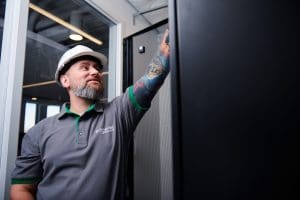
The data center industry has fast become an engine for growth and creativity across industries, powering a massive AI scale-up. Yet, the same data center growth engine faces a new energy landscape that can inhibit it.
Driven by this data economy, data center operators desire to meet the moment – and remove those barriers to progress. Battery Energy Storage Systems – BESS for short – can help do just that: address challenges around mounting energy costs and degrading grid stability. They can make better use of renewables to reduce emissions while maintaining availability.
Plus, improvements in lithium-ion batteries have transformed BESS into an affordable, safe, and efficient option for many operators.
So, let’s do a quick rundown on defining what a BESS is, the trends driving adoption for data centers, and how Battery Energy Storage Systems can help power data centers today and in the future.
What is a Battery Energy Storage System (BESS)?
A BESS stores energy from the utility grid and/or renewable energy sources, and supplies energy either back to the grid or to a load. It can be optimized depending on financial, sustainability, and/or resiliency requirements. Each BESS is distributed energy resource (DERs). It’s an electrochemical device.
A Battery Energy Storage Systems (BESS) stores (typically) one to two hours of energy in batteries to help stabilize the grid, provide additional backup power and independence from the grid, reduce diesel generator needs, lower energy costs, and take better advantage of renewables. BESS take several seconds to come online and start discharging to connected loads.
While BESS appear the same as an uninterruptable power supply (UPS), they’re not. They’re complementary. A UPS is designed to provide uninterrupted power to critical loads for five to fifteen minutes when power is lost. Schneider Electric White Paper 185, Understanding BESS: Battery Energy Storage Systems for Data Centers, provides a much more detailed description of BESS and their functions.
Market and technology trends driving BESS adoption in data centers
Several key trends are pushing data centers to embrace BESS technology:
Increasing renewable energy penetration
With vast deployments of solar and wind energy growing greener energy globally, their intermittent supply and low inertia, however, creates grid stability challenges for grid operators. BESS can be used to help balance supply and demand, stabilize frequency, and store surplus renewable energy for use later, helping to stabilize the larger grid and improve energy utilization.
There are two forms of BESS, FTM (Front of the Meter) and BTM (Behind the Meter). The former is the purview of utility storage. The latter is accessible for data centers looking to safeguard continuity and resilience. The increasing need for this capability is resulting in markets (e.g., grid services) and other incentives (e.g., peak shaving) to help pay for and monetize BESS as an asset.
Rising energy prices and supply constraints
Volatile energy costs and utility supply create uncertainty for facility operators.
BTM BESS can increase energy independence while reducing energy bill cost savings. In its simplest form, it allows operators to store energy when prices are lower and use it when utility prices are high. Stored energy can also be used to peak shave# to avoid costly demand charges that reduce energy bills, increasing operational efficiencies.
A Battery Energy Storge Systems (BESS) can also protect the facility, should the utility be constrained and unable to meet peak power needs. When this happens, BESS can bridge the gap with more power required during peak times. Often sized for the whole site or, at least for critical loads, BESS energy can be used when grid supply is unstable.
Government policy and incentives; public pressure
BTM BESS is experiencing an uplift as governments and facilities are seeking greening options. A combination of regulatory pressure, net metering programs and time-of-use (TOU) rate structures are helping grow renewable usage while providing incentives to adopt. Taking advantage of these opportunities can have a significant positive impact on the ROI of BESS.
Sustainability advocates in many local governments are also driving to reduce air and noise pollution. Their efforts have led to permitting challenges and other operational limitations for data centers relying on diesel generators in their uptime toolkit.
In one case, persistent objections and protests by the public plagued one large data center owner. They chose BESS instead of diesel gensets to remove the pressure and move forward with construction. As diesel gensets experience increased pressure, BESS can become practical alternatives.
Battery technology advancements
Early BESS systems used older lead-acid type batteries. These are not the best choices today. For newer technologies needing energy dense storage, such as EV (Electric Vehicle) and BESS, lithium-ion batteries have become the optimal technology choice. Compared to traditional lead-acid, li-ion batteries have much higher energy density, longer lifespans, higher cycle life, and are better optimized for multi-hour runtimes.
Declining costs
The cost of BESS components has been in decline due to increasing production and improved design and manufacturing. As a result, they have become a more attractive investment for data center owners.
BESS can improve how data centers are powered now and in the future
BESS installed onsite provide data center owners with five potential key outcomes that bring resiliency, deployment speed, sustainability, and cost benefits:
- Additional backup power and greater independence from the grid
- Decreased reliance on, or elimination of the need for, diesel generators
- Market participation (grid services)
- Demand charge avoidance and time-of-use/tariff management
- Increased use of renewables
The rise of BESS technology presents a compelling opportunity for data centers to address energy challenges, reduce energy costs, deploy faster when constrained by genset permitting, and to help achieve sustainability goals. As demand for data centers continues to surge, Battery Energy Storage Systems are poised to play a vital role in powering the future of this critical industry. To take the next step in deciding if BESS is right for your data center, visit and explore Schneider Electric’s comprehensive BESS offer.
Get Schneider Electric White Paper 185, Understanding BESS: Battery Energy Storage Systems for Data Centers, explains in detail how these outcomes are realized.




Add a comment